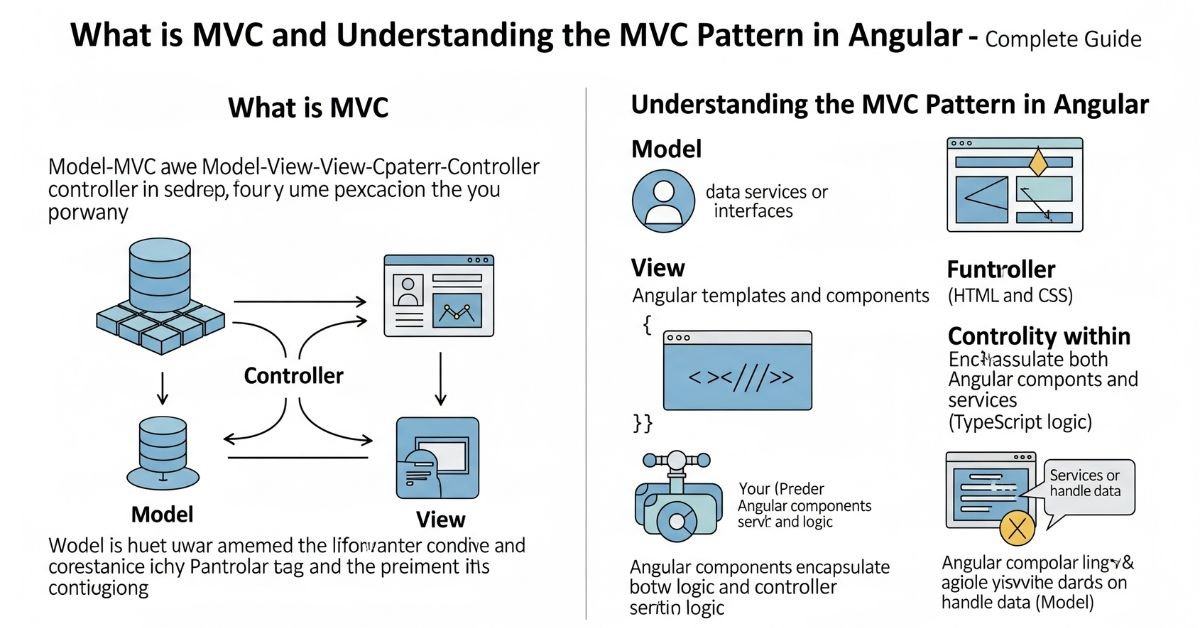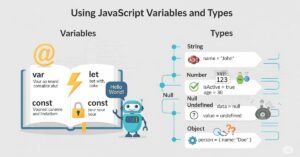The subject of MVC and learning the MVC Pattern in Angular – Complete Guide is relevant to web developers. MVC, or Model-View-Controller, is a design pattern that you can use to structure code in an orderly fashion. For Angular, MVC concepts help you structure your application in separate layers.
Structuring your application in this way makes the project simpler to manage, test, and scale. With knowledge of MVC in Angular, you can create applications that are quicker to develop and simpler to maintain. In this guide, we will learn MVC from scratch to real-world examples, allowing you to apply it in real Angular projects.
What is MVC
The Model-View-Controller pattern is a way to structure applications. It divides an app into three parts. The Model handles data and business logic. The View manages the user interface. The Controller connects them and processes user actions.
This idea started in the late 1970s in the Smalltalk programming language. Over time, MVC became one of the most popular software architecture patterns. The main goal is the separation of concerns, meaning each part of the app has its job. This leads to cleaner code and easier teamwork.
Read more About : How to Add Angular Features to the Project
Core Components of MVC
In MVC, the Model is in charge of storing, retrieving, and updating data. This could be from a database, API, or local storage. It knows nothing about the user interface.
The View shows data to the user. It could be HTML, templates, or UI components. It listens to changes in the model and updates the display.
The Controller takes input from the user. It tells the model to change data and updates the view. The three parts work together in a flow: user interacts → controller processes → model updates → view refreshes.
MVC Components Overview
| Component | Responsibility | Example in Angular |
| Model | Data & business logic | Services, data models |
| View | User interface | HTML templates |
| Controller | Processes input & updates model/view | Components, event methods |
Advantages of Using MVC
One major benefit of MVC is modularity. You can work on the UI without touching the data layer. This makes projects easier to maintain and extend.
MVC also supports parallel development. One developer can work on the model, another on the view, and another on the controller at the same time. Testing is easier, too, because you can test each part separately.
It also improves scalability. As your app grows, MVC helps you add new features without breaking existing ones. This is why it’s used in many enterprise-level projects.
MVC Compared to Other Design Patterns
MVC is often compared to MVVM (Model-View-ViewModel) and MVP (Model-View-Presenter). In MVVM, a ViewModel acts as a bridge between the view and the model, handling most of the UI logic. In MVP, the Presenter handles logic but is more involved in updating the UI directly.
MVC is best when you want a clear separation and simpler control flow. MVVM is great for data-binding-heavy frameworks like Angular. MVP works well for applications with complex UI interactions.
Read more : Angular RouterLinkActive: A Complete Guide to Active Link Styling in Angular
MVC vs MVVM vs MVP
| Pattern | Key Middle Layer | Best For | Example Framework |
| MVC | Controller | General web apps, REST services | ASP.NET MVC |
| MVVM | ViewModel | Data-binding-heavy UIs | Angular, WPF |
| MVP | Presenter | Complex UI logic | Android, WinForms |
Angular’s Relationship with MVC
Angular is not a pure MVC framework. It’s a component-based framework that also uses concepts from MVVM. However, you can still apply MVC ideas to organize code in Angular.
Many developers call Angular an MVC framework because components can act like controllers, services act like models, and templates serve as views. This mapping works well for understanding data flow in Angular.
Mapping MVC to Angular Components
In Angular, the Model is usually handled by services. These services store data, make API calls, and process business rules. They do not touch the UI.
The View is made of Angular templates. These contain HTML, directives, and bindings that display data. The Controller-like role is handled by components. Components receive data from services and send it to the view. They also handle user events.
Mapping MVC Roles to Angular
| MVC Role | Angular Equivalent | Description |
| Model | Services, data models | Handles data and logic |
| View | Templates (HTML + bindings) | Displays the UI |
| Controller | Components | Connects model and view, handles UI |
Practical Example – Applying MVC in Angular
Imagine you are building a task manager app. The Model would be a service that stores tasks and communicates with an API. It might have methods like getTasks() and addTask().
The View would be an HTML template showing a task list and a form to add new tasks. The Controller would be a component that calls the service methods when a user submits a task and updates the view accordingly. This keeps data logic, UI, and interaction code separate.
Common Misunderstandings About MVC in Angular
Some developers think Angular is strictly MVC. It’s not. Angular blends MVC ideas with MVVM and a component-based approach. This flexibility is an advantage, but it also confuses.
Another misunderstanding is mapping every service, component, and template exactly to MVC terms. In real life, Angular’s structure is more flexible, so strict MVC mapping isn’t always needed.
You will like : Angular vs jQuery, React, and Vue.js: A Detailed Comparison for 2025
Best Practices for Using MVC Principles in Angular
Keep services focused only on data and business logic. Avoid putting UI logic there. Keep components lean by delegating heavy logic to services. Keep views simple with minimal logic, focusing on presentation.
Always maintain loose coupling between layers. This makes it easier to change or replace parts of your app without breaking others. Also, write unit tests for each layer separately to catch bugs early.
FAQ” s
Is Angular an MVC framework?
No. Angular is component-based but uses MVC-like concepts.
Can I use strict MVC in Angular?
Yes, but it’s not always practical. Angular’s flexibility often works better.
What’s the main benefit of MVC in Angular?
It makes code cleaner, easier to test, and more maintainable.
Does MVC slow down Angular apps?
No. If done well, MVC can improve performance by organizing logic.
Is MVC outdated?
Not at all. It’s still widely used, especially in large projects.
Conclusion
What is MVC, and Understanding the MVC Pattern in Angular – Complete Guide helps you see how MVC ideas can make Angular apps cleaner and easier to maintain. While Angular is not strictly MVC, applying its principles improves code structure, teamwork, and scalability. The key is to adapt MVC to Angular’s strengths, not to force it. By separating concerns, keeping components lean, and testing each layer, you’ll build Angular apps that are easier to grow and manage.




